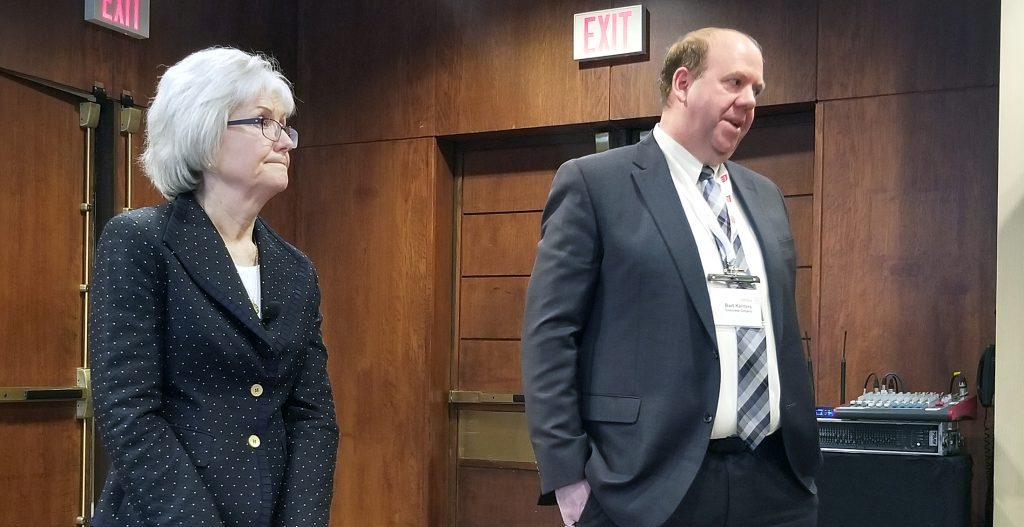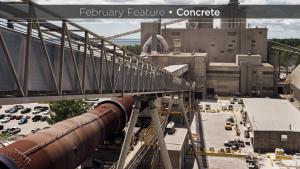Ontario Ministry of Transportation (MTO) environmental initiatives and changes to concrete standards were the headlining topics of a session during the Ontario Road Builders’ Association (ORBA) convention held recently in Toronto.
Bart Kanters, president of Concrete Ontario, discussed reducing the greenhouse gas emissions of concrete itself as part of the MTO’s Greenhouse Gas Reduction Initiative.
“Cement is a key ingredient when it comes to concrete but it has a fairly high environmental footprint due to the fact that we have to heat limestone up to 1,400 or 1,600 degrees in order to produce the material,” explained Kanters. “Our CO2 emissions come from the fuel that we need to heat the material up to that high temperature and then the fact that when we heat it up, it goes through some significant chemical changes that release the carbon that is trapped in the limestone.”
Starting in January 2018, the MTO identified a greenhouse gas emission target of at least 10 per cent on all MTO contracts and 20 per cent on a number of key projects.
“The whole objective here is to try and bring down the overall carbon dioxide content of the final mix design,” said Kanters. “One option to meet that reduction limit is Portland limestone cement, another is to use supplementary cementing materials (SCM). Limestone fillers are also an option.”
The key difference between Portland limestone cement and general use cement is up to 15 per cent limestone is added to the Portland cement.
“Because we have not run that limestone through the cement kiln, we have not heated it up, we have not released the carbon in that material. We are reducing the CO2 contribution of the concrete by about 10 per cent,” said Kanters. “As an industry we are moving towards using this product for all applications.”
Supplementary cementing materials can also be used.
“We could use slag or fly ash to meet those objectives,” said Kanters. “They offer other benefits as well when it comes to reducing permeability and creating concrete that is more durable. We need to recognize there are limits when it comes to ready-mix concrete for supplementary cementing materials and you can’t exceed those on MTO contracts.”
The MTO also has projects with a higher target of 20 per cent GHG emission reduction.
“There is a number of MTO contracts that are out currently that have those limits and they are identified to ORBA and the ready-mix associations. We know what projects they are,” said Kanters. “Some of the critical factors you have to keep in mind is that you can’t blend materials…you need to pick one material and use that consistently throughout the project.”
Applications where the contractor should request an exemption are with early strength development, said Kanters.
“When we are looking at fast track concrete then that becomes a little more challenging to use supplementary cementing materials, they tend to slow down the chemical reaction,” said Kanters. “While we can still utilize SCMs for those applications, quite frankly we are not reducing the CO2 contribution when we do that.
“There are applications where it doesn’t make sense from a logical standpoint and that’s where we’ve been working with the MTO to identify a few specific applications where we’re not meeting our overall objective.”
Hannah Schell, head of concrete for the MTO, said there are changes being made in three different areas to the specifications for concrete pavement.
“The first one was the real driver for the changes and that was to address problems with premature pavement joint deterioration,” explained Schell.
“The second reason for changes was to include ride smoothness, that’s important for drivers and finally to update requirements. It was quite old and we wanted to make it consistent with a number of other MTO policies. We did implement a new non-standard specification in March 2018 that’s in jobs now and we are monitoring that very closely to see if we have made enough changes, particularly when it comes to the joint deterioration.”
The first signs of deterioration became apparent on Highway 417 eight years after construction, Schell said. Investigations found the joints were visibly deteriorating both on and beneath the surface.
“Concrete that is totally full of water, when it is subjected to freeze thaw cycles, water expands into ice and it breaks the concrete,” explained Schell. “It was a big concern and we needed to make some serious changes in our concrete pavement specifications to try and deal with this. This isn’t unique to Ontario, it’s been happening across the northern United States for a number of years. We thought we weren’t seeing it but we are, it’s just taking a little longer to happen.”
One of the changes is increasing the strength level from 30 to 35 MPA.
“We’ve added requirements for hardened air voids and for rapid chloride permeability of concrete,” said Schell. “Both of those are indicators of quality so we’re trying to make sure we’re getting the best possible quality of concrete.”











Recent Comments
comments for this post are closed